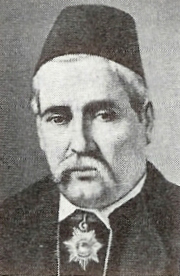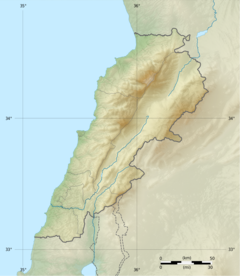History
The Lee Observatory opened in 1873, with Doctor Cornelius Van Dyck as its pioneer. The observatory was named in reference to Henry Lee, a wealthy British merchant from Manchester, who had made a significant donation to help finance its construction.
The observatory had twin roles of sky gazing and serving as a meteorological station for the middle east.
Several directors and assistants managed the Observatory, including Van Dyck, who pursued astronomy as a hobby and had bought most of the equipment himself, and Professors Mansour Jurdak and Owen Gingerich, who organised the "Open Nights Observatory" events and made contributions to the observatory library. Saad Sami Haddad drew a sky map of stars up to and including the 5th magnitude. He contributed in the filing of sunspot data taken daily and forwarded them to Zurich, the international center for sunspot research. Haddad made statistical tests revealing the significance of the East-West asymmetry of the sunspots activity, and was responsible for the gathering of meteorological data.

The Lebanese Civil War was a multifaceted civil war in Lebanon, lasting from 1975 to 1990 and resulting in an estimated 120,000 fatalities. As of 2012, approximately 76,000 people remain displaced within Lebanon. There was also an exodus of almost one million people from Lebanon as a result of the war.

Butrus al-Bustani was a writer and scholar from present day Lebanon. He was a major figure in the Nahda, which began in Egypt in the late 19th century and spread to the Middle East.

Temple Chevallier FRAS was a British clergyman, astronomer, and mathematician. Between 1847 and 1849, he made important observations regarding sunspots. Chevallier has been called "a remarkable Victorian polymath". Not only did he write many papers on astronomy and physics, he also published a translation of the Apostolic Fathers that went into a second edition, and translated the works of Clement of Alexandria, Polycarp and Ignatius of Antioch.

Cornelius Van Alen Van Dyck, M.D. was an American missionary and translator of the Bible into Arabic.

The US National Center for Atmospheric Research is a US federally funded research and development center (FFRDC) managed by the nonprofit University Corporation for Atmospheric Research (UCAR) and funded by the National Science Foundation (NSF). NCAR has multiple facilities, including the I. M. Pei-designed Mesa Laboratory headquarters in Boulder, Colorado. Studies include meteorology, climate science, atmospheric chemistry, solar-terrestrial interactions, environmental and societal impacts.

The Royal Observatory of Belgium, has been situated in the Uccle municipality of Brussels (Belgium) since 1890. It was first established in Saint-Josse-ten-Noode in 1826 by William I under the impulse of Adolphe Quetelet. It was home to a 100 cm (39 in) diameter aperture Zeiss reflector in the first half of the 20th century, one of the largest telescopes in the world at the time. It owns a variety of other astronomical instruments, such as astrographs, as well as a range of seismograph equipment.

Sami Ibrahim Haddad, Arabic: سامي ابراهيم حداد was a doctor, surgeon and writer. He was born in Palestine and spent most of his life in Lebanon.
Sami Haddad was the Lebanese minister of Economy and Trade.

The Toronto Magnetic and Meteorological Observatory is a historical observatory located on the grounds of the University of Toronto, in Toronto, Ontario, Canada. The original building was constructed in 1840 as part of a worldwide research project run by Edward Sabine to determine the cause of fluctuations in magnetic declination. Measurements from the Toronto site demonstrated that sunspots were responsible for this effect on Earth's magnetic field. When this project concluded in 1853, the observatory was greatly expanded by the Canadian government and served as the country's primary meteorological station and official timekeeper for over fifty years. The observatory is considered the birthplace of Canadian astronomy.
This is an index to articles about terms used in discussion of radio propagation.

The King's Observatory is a Grade I listed building in Richmond, London. Now a private dwelling, it formerly housed an astronomical and terrestrial magnetic observatory founded by King George III. The architect was Sir William Chambers; his design of the King's Observatory influenced the architecture of two Irish observatories – Armagh Observatory and Dunsink Observatory near Dublin.

Aabey, also spelled Abey, is a village located in Mount Lebanon, in Aley District of Mount Lebanon Governorate. It is located 22 km (14 mi) from Beirut and has an altitude of 800 m. It is bordered by Kfarmatta (South), Al Bennay (East), Damour (West), and Ain Ksour (North). It overlooks Damour and the capital Beirut and the sea can be seen from virtually any point in the village. Aabey contains the Dawdye college, Aabey Vocational School (Mihanye) etc.

The Stonyhurst Observatory is a functioning observatory and weather station at Stonyhurst College in Lancashire, England. Built in 1866, it replaced a nearby earlier building, built in 1838, which is now used as the Typographia Collegii.

Regional Meteorological Centre, Chennai is one of the six regional meteorological centres (RMCs) of the India Meteorological Department (IMD) and is responsible for the weather-related activities of the southern Indian peninsula comprising the states of Andhra Pradesh, Telangana, Karnataka, Kerala, Tamil Nadu and the union territories of Andaman and Nicobar, Lakshadweep Islands and Puducherry. The other regional centres are located at Kolkata, Guwahati, Mumbai, Nagpur and New Delhi.

Elizabeth Brown was a British astronomer and Quaker who specialized in solar observation, especially sunspots and solar eclipses.

The Free Lebanon State, also known as the State of Free Lebanon was an unrecognized puppet state of Israel, announced by Saad Haddad, Lebanese politician and commander of the Maronite-Christian dominated South Lebanon Army on the course of the Lebanese Civil War. The announcement was made on 18 April 1979, exercising authority in parts of Southern Lebanon. The state failed to gain international recognition and its authority deteriorated with the death of Saad Haddad in 1984, retaining only a provisional administration and an associated SLA militia.

The Crohamhurst Observatory is a heritage-listed observatory at 131 Crohamhurst Road, Crohamhurst, Sunshine Coast Region, Queensland, Australia. It was built in 1935. It was added to the Queensland Heritage Register on 13 November 2008.

Fuad Sami Haddad was a neurosurgeon, humanitarian, and writer. He was born in Beirut and spent most of his life in Lebanon.
The 25–26 January 1938 geomagnetic storm was a massive solar storm which occurred 16–26 January with peak activity on 22, 25 and 26 January and was part of the 17th solar cycle. The effects of the storm were extremely limited, the electrification of Europe and North America was still in its infancy.

Lebanese and Hezbollah officials reported that at 2:30 a.m. local time on 25 August 2019, two drones crashed into the Dahieh district of Beirut, Lebanon. According to Lebanese officials, Israel launched a drone attack. Hezbollah denied exploding or targeting the drones. It was the first such incident between Israel and Lebanon since the 2006 Lebanon War.


















